When director Sam Mendes first contacted makeup and hair designer Naomi Donne about his World War I film, 1917, her natural reaction was immediate agreement to participate. However, Mendes’ film came with a caveat: the action would be staged as if the entire movie was one continuous shot. “We would rehearse for months, and then just shoot it in real time,” Oscar-nominated Donne described. “How am I going to make that work? Because we had a very, very long prep time, and Sam knew every single frame. Also, the crew was so collaborative—we were in and out of each other’s departments in a way I’ve never done before. These challenges, when it works, is so fantastic.”
Over 15 weeks, principal photography took place, primarily in Salisbury Plain in the west of England—a very large land area which is considerably flat. Additional material was shot at Newcastle in northeast England and at Covington Airfield, with interiors at Shepperton Studios.
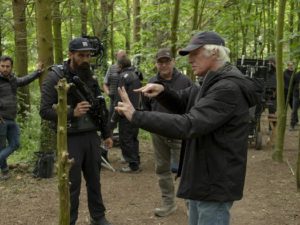
With the majority of the film being realized on practical exterior locations, the 1917 cast and crew were beholden to the English weather, with overcast days actually preferable, given Roger Deakins’ cinematographic concept. “Some days, you get 600 men ready, and then the sun would come out, but you can only shoot if it was cloudy,” said Donne of her makeup challenges, shared with co-nominee Rebecca Cole, the key makeup and hair artist on the project, and prosthetics designer Tristan Versluis. “If it was sunny out, you couldn’t shoot, [so] they’d rehearse and rehearse. A lot of shots [involved] people sitting around waiting for the sun to go in.”
Even though 1917 appears as if it was accomplished in one continuous shot, individual scenes were divided up into sections and filmed separately, some of which were nine-minutes-long. “We shot in sequence,” Donne explained. “That made it a lot easier—we could look at everything in a very detailed way. Sam knew the exact range of every shot, months before we shot it. I never had so much preparation in my life. It was very much like working in the theater.”
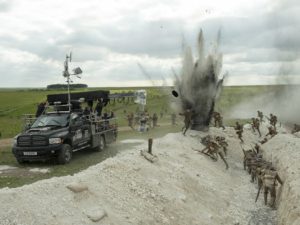
In planning the full project, sets were constructed based on the time it would take actors to maneuver through facsimiles of the Great War’s notorious trenches, some of which measured a mile long. “The fact that we were that prepared made it easier than you might think,” Donne stated of the production process. “We prepped in the trenches when the set was built; even though we weren’t shooting, we put everyone in costume and made them up, to get the feeling of the film and have notes from Sam. Some days, if we got the shot, we got a nine-minute shot in a day where most films would take a week. We actually finished ahead of schedule.”
In order to create makeup and hairstyles for the primary actors, Donne, Cole, and three assistants were required. For scenes which called for 7000 extras, the makeup crew expanded to 40 or 50 makeup artists and hair stylists. Then, for a sequence at the end of the film, another 10 artists were brought onto the crew to devise makeup for injured soldiers in a medical tent. “We had a prosthetic makeup designer, Tristan Versluis, in Spain,” Donne stated. “He moves to London when he gets a big project. We set up a prosthetic workshop and a makeup workshop at Shepperton.”
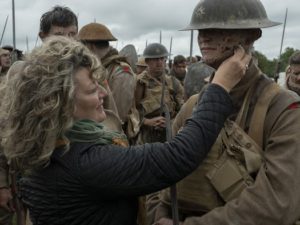
Most critical to Versluis’ duties was making sure that the soldiers appeared totally authentic throughout 1917. In one unforgettable scene, actor George MacKay, playing Lance Corporal Schofield, is pumping water from a well, just after a German plane has just crashed. Then, the downed German pilot stabs Dean-Charles Chapman, playing Lance Corporal Blake, Schofield’s partner.
To present the moment, Deakins’ camera pans across the scene, continuously from Schofield to Blake, who is in the distance, being stabbed by the pilot, causing Blake to start bleeding out. “Tristan had to rig that on a remote-controlled blood rig, and make that work at exactly the right time for the exact right amount of blood,” Donne detailed. “I knew that the shot was wide, so we could make [Blake look] pale. By the time the camera pushes into his face, the paleness was appropriate.”
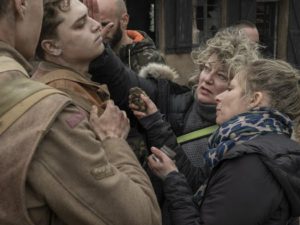
In collaborating with Mendes, Deakins, and other key crew, Donne had a goal on 1917 of making her makeup and hair visages as invisible as possible. “Tell the story that the director is trying to tell in the most unobtrusive way,” she said of her methodology, ‘”by creating characters who have gone through a terrible experience. All of that shows somehow on their face—that’s my job. The shot in the pine forest, and you see all of those faces—haircuts, teeth, dirt—[involved] months of documentaries, research, and stills. I really believe that those soldiers were about to go off to war; that’s what I was trying to achieve, and something that an audience just feels.”
With 1917 ranking as one of her most memorable film experiences, Donne, who works with a similar core team on most of her motion pictures, related how the film profoundly affected its entire cast and crew. “We were infected by Sam’s passion for the project,” she conveyed.
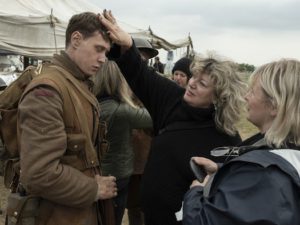
As would be expected, Donne was overwhelmed in getting an Oscar nomination, as she knew her peers were responsible for the voting, through several rounds of the Academy Awards’ processes. “I just do the work and never expect it,” she said of the acknowledgement. “I don’t want people to notice my work. I felt honored and thrilled by the whole experience—one of the greatest moments of my career.”





